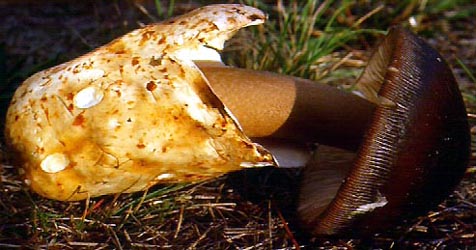|
[ Section Vaginatae page. ]
[ Amanita Studies home. ]
[ Keys & Checklist/Picturebooks ] "Stuntz' Great Ringless Amanita"
Technical description (t.b.d.) BRIEF DESCRIPTION: The cap of A. pachycolea is 70 - 120 mm wide, convex to near campanulate when young, becoming convex to plano-convex to umbonate in age, viscid to subviscid, with a decurved margin (becoming rimose and eroded), conspiculously striate or tuberculate striate (30 - 40% of the radius). The cap is dark brown, carob brown to mummy brown on disc, and becomes paler toward the margin (brown or grayish brown). The flesh is white and 5 - 10 mm thick above the stem. The volva is usually absent or leaves only a few fibrils; it is rarely present as a solitary white to whitish patch. The gills are adnate or decurrent by a short conspicuous hook, usually free in age, close to subdistant or occasionally crowded, white when young, unchanging or becoming tawny to orange-yellow with age, ventricose, and broad. The short gills are truncate to subtruncate, of diverse lengths, plentiful, and unevenly distributed. The stem is 110 - 240 mm long, white to olive buff to sometimes as dark as orange brown, cylindric or narrowing upward, dry, typically with appressed fibrils or fibrillose scaly, and exannulate. The flesh is white, stuffed, and becoming hollow in age. The very large, felted to membranous volva is up to 5 mm thick, white on the inner surface, white to off-white and developing rust colored to brown to yellow-brown spots with age on the outer surface. The volva is up 80 mm from the stem base to the top of its highest limb and collapsing in age. The spores measure (7.8-) 10.0 - 13.5 (-16.5) x (7.5-) 8.8 - 11.8 (-14.0) Ám and are globose to subglobose to broadly ellipsoid and inamyloid. Clamps are absent from, or infrequently found on, bases of basidia. This species occurs from southwestern Canada to central California. Related species with copious volvas and often large fruiting bodies include A. magnivolvata Aalto and A. pachyvolvata (Bon) Krieglst. of Europe and A. violettae Tulloss of eastern North America. The photographed specimen had been stored in a large glass jar and refrigerated for a day or two before the picture was taken. The normal discoloring of the volva was apparently accentuated by the process. -- R. E. Tulloss Photo: R. E. Tulloss
[ Section Vaginatae page. ]
[ Amanita Studies home. ]
[ Keys & Checklist/Picturebooks ] Last changed 14 October 2009. |
